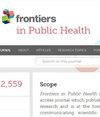一家大型全国连锁药店的患者接受 COVID-19 检测的健康公平性
IF 3
3区 医学
Q2 PUBLIC, ENVIRONMENTAL & OCCUPATIONAL HEALTH
引用次数: 0
摘要
背景一些健康的社会决定因素和其他结构性因素造成了 COVID-19 风险、发病率和死亡率方面的种族和民族差异。与社区药房的公私合作成功地扩大了 COVID-19 检测的覆盖面,并惠及了历来服务不足的社区。本研究的目的是描述在全国连锁社区药房寻求 COVID-19 检测的个人,并了解在检测途径、阳性率和感染新出现的相关变异株方面可能存在的种族和民族不平等现象。方法我们对 2021 年 5 月 1 日至 2022 年 2 月 28 日期间在沃尔格林药房或沃尔格林附属大规模检测点接受 COVID-19(SARS-CoV-2)检测的年龄≥18 岁的个人进行了横断面研究。阳性率是指在所有进行的检测中呈阳性的比例。对检测结果呈阳性的地理平衡随机子集进行全基因组测序,以确定特定的病毒变体(α、δ和Ω)。逻辑回归估算了几率比(ORs)和 95% 置信区间(CIs),以比较不同种族和族裔群体中检测结果呈阳性和检测结果呈阳性并带有新出现的相关变异体的可能性。与白人相比,美国印第安人或阿拉斯加原住民(OR = 1.12; 95%CI = 1.10-1.13)、西班牙裔或拉丁裔(1.20; 95%CI = 1.120, 1.21)和黑人(1.12; 95%CI = 1.12, 1.13)更有可能检测出 COVID-19 阳性。非白人也更有可能对令人担忧的新变异株检测呈阳性(例如,在从 delta 到 omicron 的过渡期内,黑人对 omicron 检测呈阳性的可能性是白人的 3.34 (95%CI = 3.14-3.56) 倍)。讨论利用全国检测数据数据库,我们发现 COVID-19 检测呈阳性和新病毒株检测呈阳性的可能性存在种族和民族差异。这些结果证明了与当地药店和连锁药店开展公私合作的可行性,以支持大流行应对措施,并为较难接触到的人群提供重要的医疗服务。本文章由计算机程序翻译,如有差异,请以英文原文为准。
Health equity in COVID-19 testing among patients of a large national pharmacy chain
BackgroundSeveral social determinants of health and other structural factors drive racial and ethnic disparities in COVID-19 risk, morbidity, and mortality. Public-private collaborations with community pharmacies have been successful in expanding access to COVID-19 testing and reaching historically underserved communities. The objectives of this study were to describe individuals who sought testing for COVID-19 at a national community pharmacy chain and to understand potential racial and ethnic inequities in testing access, positivity, and infection with emerging variants of concern.MethodsWe conducted a cross-sectional study of individuals aged ≥18 who were tested for COVID-19 (SARS-CoV-2) at a Walgreens pharmacy or Walgreen-affiliated mass testing site between May 1, 2021 and February 28, 2022. Positivity was defined as the proportion of positive tests among all administered tests. A geographically balanced random subset of positive tests underwent whole genome sequencing to identify specific viral variants (alpha, delta, and omicron). Logistic regression estimated odds ratios (ORs) and 95% confidence intervals (CIs) to compare the likelihood of testing positive and testing positive with an emerging variant of concern across race and ethnicity groups.ResultsA total of 18,576,360 tests were analyzed (16.0% tests were positive for COVID-19; 59.5% of tests were from White individuals and 13.1% were from Black individuals). American Indian or Alaska Native (OR = 1.12; 95%CI = 1.10–1.13), Hispanic or Latino (1.20; 95%CI = 1.120, 1.21), and Black (1.12; 95%CI = 1.12, 1.13) individuals were more likely to test positive for COVID-19 compared to White individuals. Non-White individuals were also more likely to test positive for emerging variants of concern (e.g., Black individuals were 3.34 (95%CI = 3.14–3.56) times more likely to test positive for omicron compared to White individuals during the transition period from delta to omicron).DiscussionUsing a national database of testing data, we found racial and ethnic differences in the likelihood of testing positive for COVID-19 and testing positive for emerging viral strains. These results demonstrate the feasibility of public-private collaborations with local pharmacies and pharmacy chains to support pandemic response and reach harder to reach populations with important health services.
求助全文
通过发布文献求助,成功后即可免费获取论文全文。
去求助
来源期刊

Frontiers in Public Health
Medicine-Public Health, Environmental and Occupational Health
CiteScore
4.80
自引率
7.70%
发文量
4469
审稿时长
14 weeks
期刊介绍:
Frontiers in Public Health is a multidisciplinary open-access journal which publishes rigorously peer-reviewed research and is at the forefront of disseminating and communicating scientific knowledge and impactful discoveries to researchers, academics, clinicians, policy makers and the public worldwide. The journal aims at overcoming current fragmentation in research and publication, promoting consistency in pursuing relevant scientific themes, and supporting finding dissemination and translation into practice.
Frontiers in Public Health is organized into Specialty Sections that cover different areas of research in the field. Please refer to the author guidelines for details on article types and the submission process.
 求助内容:
求助内容: 应助结果提醒方式:
应助结果提醒方式:


